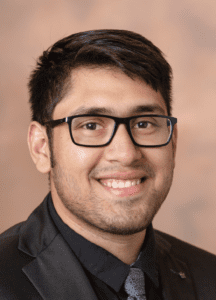Posted By: HGG Advances
Each month, the editors of Human Genetics and Genomics Advances interview an early-career researcher who has published work in the journal. This month we check in with Souhrid Mukherjee to discuss his paper “Personalized structural biology reveals the molecular mechanisms underlying heterogeneous epileptic phenotypes caused by de novo KCNC2 variants”.

HGGA: What motivated you to start working on this project?
SM: Working with the Vanderbilt University Undiagnosed Diseases Network (UDN) team during my PhD demonstrated the critical need for better approaches to variant interpretation in rare diseases. And even after a candidate gene and variant are identified, I observed that the molecular effects of the variant and the pathogenic mechanism often remained unresolved. Understanding these processes is crucial for confirming the diagnosis and evaluating possible treatments.
Our research team saw an opportunity to help fill this interpretation gap and reveal the molecular mechanisms underlying rare diseases with an approach we call “Personalized Structural Biology” (PSB). PSB integrates population genetics, computational structural biology, and targeted experimental validation. The work described in this paper focuses on a de novo variant in a potassium ion channel (KCNC2 p.Val469Leu) that was a candidate for a novel encephalopathy.
HGGA: What about this paper/project most excites you?
SM: Using our personalized structural biology approach, we demonstrated how the single, seemingly conservative (valine to leucine), variant observed in the UDN individual can lead to severely altered molecular function and physiology consistent with the observed phenotypes. We also predicted and validated divergent effects for another recently identified candidate variant (p.Val471Leu) just two amino acids away in sequence from our candidate variant. This illustrates the importance of incorporating mechanistic structural hypothesis into variant interpretation — both variants are pathogenic, but they differ in their mechanisms.
HGGA: What do hope is the impact of this work for the human genetics community?
SM: Our hope is that this work provides a template for early integration of computational 3D protein structural modeling into the evaluation pipeline for rare genetic variants. Our work was enabled by rapid iterative feedback between clinicians and wet and dry lab scientists. Ultimately, our hope is that this will lead to the discovery of the mechanisms of more rare diseases and, ultimately, treatments.
HGGA: What are some of the biggest challenges you’ve faced as a young scientist?
SM: The biggest challenge I have faced has been finding the balance between fulfilling degree requirements and pursuing exciting research avenues. Furthermore, during COVID, working from home did not make collaborations easier, and it was difficult to liaise with a multidisciplinary team such as the one we worked with for this project. However, my mentors Dr. Capra and Dr. Meiler and my collaborators Dr. Kuenze, Dr. Li, Dr. Hu, Dr. Tao and Dr. Roden, made it much easier to work together and pursue the project to completion.
HGGA: And for fun, what is one of the most fascinating things in genetics you’ve learned about in the past year or so?
SM: I learnt about complete uniparental isodisomy, where an individual inherits two identical copies of a chromosome from a single parent. While this is rare, the resulting homozygosity can result in suspicions of consanguinity, which, I can imagine, could lead to uncomfortable conversations at genetic counseling centers!
